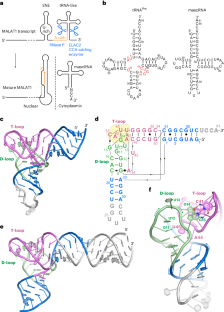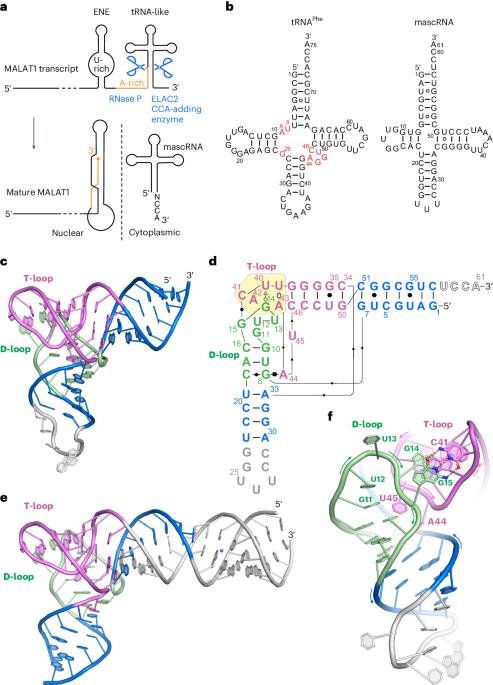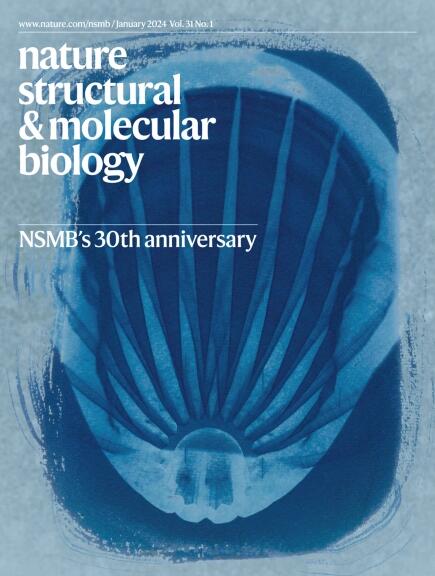MALAT1 RNA 成熟和 mascRNA 生物发生的结构基础
IF 12.5
1区 生物学
Q1 BIOCHEMISTRY & MOLECULAR BIOLOGY
引用次数: 0
摘要
转移相关肺腺癌转录本1(MALAT1)长非编码RNA(lncRNA)在调控转录、剪接、肿瘤发生等方面具有关键作用。MALAT1的成熟和稳定需要RNase P的精确加工,同时启动3′细胞质MALAT1相关小细胞质RNA(mascRNA)的生物生成。mascRNA被认为折叠成类似于转运RNA(tRNA)的二级结构,但缺乏典型tRNA折叠所需的8个保守连接残基。在这里,我们报告了人类 mascRNA 加工前后的晶体结构,它显示了一种超紧凑的准 tRNA 样结构。尽管缺少所有连接残基,mascRNA 还是忠实地再现了 tRNA 特有的 "肘 "特征,以吸引 RNase P 和 ElaC 同源蛋白 2 (ELAC2) 进行加工,而这两种蛋白表现出不同的底物特异性。D 干和反密码子区域的旋转和重新定位排除了 mascRNA 的氨基酰化,避免了对翻译的干扰。因此,一类后生动物的 lncRNA 基因座利用以前未曾认识到的、异常精简的准 tRNA 结构来招募特定的 tRNA 处理酶,同时排除其他酶,以驱动定制的 RNA 生物发生、处理和成熟。本文章由计算机程序翻译,如有差异,请以英文原文为准。


Structural basis of MALAT1 RNA maturation and mascRNA biogenesis
The metastasis-associated lung adenocarcinoma transcript 1 (MALAT1) long noncoding RNA (lncRNA) has key roles in regulating transcription, splicing, tumorigenesis, etc. Its maturation and stabilization require precise processing by RNase P, which simultaneously initiates the biogenesis of a 3′ cytoplasmic MALAT1-associated small cytoplasmic RNA (mascRNA). mascRNA was proposed to fold into a transfer RNA (tRNA)-like secondary structure but lacks eight conserved linking residues required by the canonical tRNA fold. Here we report crystal structures of human mascRNA before and after processing, which reveal an ultracompact, quasi-tRNA-like structure. Despite lacking all linker residues, mascRNA faithfully recreates the characteristic ‘elbow’ feature of tRNAs to recruit RNase P and ElaC homolog protein 2 (ELAC2) for processing, which exhibit distinct substrate specificities. Rotation and repositioning of the D-stem and anticodon regions preclude mascRNA from aminoacylation, avoiding interference with translation. Therefore, a class of metazoan lncRNA loci uses a previously unrecognized, unusually streamlined quasi-tRNA architecture to recruit select tRNA-processing enzymes while excluding others to drive bespoke RNA biogenesis, processing and maturation. The authors uncover a Père David’s deer-like design for long noncoding RNAs such as metastasis-associated lung adenocarcinoma transcript 1 (MALAT1), which partially mimics the transfer RNA (tRNA) structure to recruit select tRNA processing enzymes for maturation and to create novel regulatory RNAs such as the MALAT1-associated small cytoplasmic RNA.
求助全文
通过发布文献求助,成功后即可免费获取论文全文。
去求助
来源期刊

Nature Structural & Molecular Biology
BIOCHEMISTRY & MOLECULAR BIOLOGY-BIOPHYSICS
CiteScore
22.00
自引率
1.80%
发文量
160
审稿时长
3-8 weeks
期刊介绍:
Nature Structural & Molecular Biology is a comprehensive platform that combines structural and molecular research. Our journal focuses on exploring the functional and mechanistic aspects of biological processes, emphasizing how molecular components collaborate to achieve a particular function. While structural data can shed light on these insights, our publication does not require them as a prerequisite.
 求助内容:
求助内容: 应助结果提醒方式:
应助结果提醒方式:


